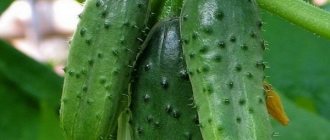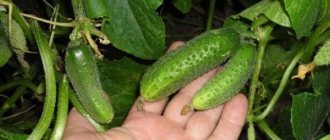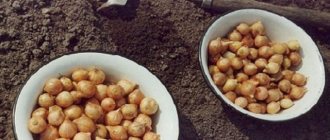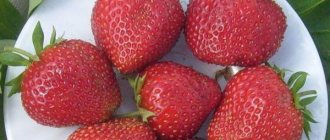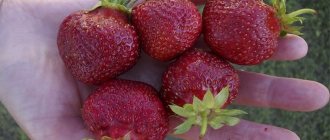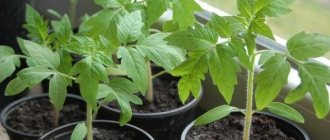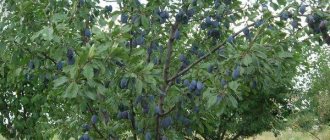Luckily for Nastya F1 will be a colorful competitor to many varieties of cucumbers. The hybrid has a lot of advantages - enviable productivity, marketability and presentable appearance.
| Landing location | Ripening time | Mode of application | Fruit length | Group | Fruit smoothness | Pollination method |
| Universal | Early ripening (35-45 days) | Universal | Short (gherkins) - less than 10 cm | Hybrid | Highly lumpy | Parthenocarpic |
Description of the bush and fruits
The bushes are medium-climbing, medium-sized. Side shoots develop evenly. Each ovary produces 5-6 greens. The leaves are wide, light green in color. The edges are wavy. The height of the bush will depend on the growing method, usually it reaches 1-1.5 meters. Female inflorescences predominate.
Note! Cucumbers have a beautiful, cylindrical shape. There are small black thorns along the entire fruit.
The skin is dense, dark green in color with noticeable white stripes along the entire greenery. The fruits are on average the same size:
- length 7-9 cm;
- diameter 2-3 cm.
The taste is delicate, without bitterness or sourness. The pulp is without voids, with small white seeds.
General information
A stable harvest of 12 to 14 kg can be harvested from 1 m2 of bed. The highest yield of the hybrid is approximately 1400 c/ha, which is almost 3.5 times higher than the maximum yield of the Asterix F1 cucumber variety, which is 422 c/ha. In greenhouse conditions, the fruitfulness of the plant will increase to approximately 30 kg/m², since Nastya prefers warmth and humidity. For large-scale production, the yield of marketable products will exceed half of the total harvest.
Note! The bushes of the plant are of medium climbing, with a weak ability to develop lateral shoots. Cucumbers are usually of medium height and do not grow more than 1 m.
Like most cucumber hybrids, the variety named after Nastya has a predominant female type of flowering. One leaf axil of a cucumber can reach an average of 5-6 ovaries. The root system is not very developed, but it needs oxygen-enriched soil. The leaves of the plant variety Nastya do not stand out:
- medium size with wrinkled roughness;
- the color is bright in shades of dark;
- The edges of the leaf are slightly wavy.
Hybrid cucumbers differ from others in their stable and strong fruits. The variety belongs to the parthenocarpic type of cucumber, that is, seeds are poorly formed in the fruit or there are no embryos in them that can overripe. Therefore, parthenocarpic cucumbers almost never turn yellow and do not overgrow.
The fruits are cylindrical with rounded ends. The length is small - from 7 to 10 cm, each weighing about 100 grams. The ratio of length to diameter is 2.9 to 1. Its color is uniform, rich, dark green, with cucumbers at the tip of a slightly brighter shade. Surface of greens:
- rough;
- with small tubercles;
- no spotting.
The inside of the cucumbers is dense, without voids, with a small number of seeds. There is no bitterness in the taste. The small fruits of the Nastya variety are well suited for canning for the winter, but will also be a juicy and crunchy addition to raw salads throughout the summer.
Preparing seedlings
The time to prepare seedlings will depend on the region and weather conditions. In the south, seedlings begin to be grown from the beginning of March, in the central areas - from mid-April, and in the north - from the 20th of April.
Seedlings can be propagated in peat pots, which are sold in flower shops, or yogurt (sour cream) cups. The container must first be treated with a 2% solution of potassium permanganate for disinfestation. In this way, the risk of plant disease can be reduced.
The next stage is preparing the soil mixture. This is a very important point, because the health of future cucumbers will depend on it. Both organic and mineral fertilizers are well suited for soil mixtures, which:
- will retain moisture;
- will provide the plant with constant access to oxygen.
The bottom of the container where the seedlings will be placed should be trimmed so that nothing interferes with the roots of the plants. You can use a regular saucer as a tray. Seedlings can be grown on peat tablets. They are placed in a container, moistened, waited for swelling, and then the seed is sown.
In order not to go through the soil disinfection procedure themselves, many people buy ready-made clean soil. Others like to cook it themselves. For this you will need:
- compost or vermicompost;
- turf land;
- sand;
- peat.
In this case, you will have to check the acidity of the soil. It must be disinfected, otherwise fungal or bacterial infections that may be in the soil will cause root rot or other unpleasant diseases.
It often happens that seeds from one pack have different conditions. This may cause not all seeds to germinate or some of them to be very weak.
Note!
In order for seedlings to germinate evenly, calibration should be carried out. As a test, place the seeds in a glass of water, then add 1.5 teaspoons of table salt.
The seeds are thrown into this solution and mixed. After some time, the heavy seeds will sink to the bottom of the glass, and the light ones will rise to the surface. Heavy seeds are washed and then left to dry for a while.
One of the most common methods of seed disinfestation is treatment with a solution of potassium permanganate. Some people use hydrogen peroxide instead of potassium permanganate. To do this, the seeds are soaked in one of the solutions mentioned above for 15 minutes. The soaking time should not be longer than 20 minutes, otherwise it will negatively affect their cultivation.
Disinsection can also be carried out using chemicals:
- Gamair-SP;
- Alirin-B.
After treatment with the preparations, the seeds do not need to be washed. Simply place them on a cloth and dry at room temperature.
Drainage is poured to the bottom, ¾ cup is filled with clean soil. Then you need to water the soil so that it becomes moist and loose. Place two or three seeds on top. They are sprinkled with 1 cm of soil and compacted a little. The plant can also be covered with film.
The temperature for germination should not be lower than +20 °C, but not higher than +28. When the first few leaves open, the temperature can be slowly reduced to +18-+20. From the second week, it is time to accustom the seedlings to temperature changes, that is, to harden them. To do this, the containers are taken outside for a short time. At first 5 minutes will be enough, but gradually increase the time to 20 minutes a day.
Diseases and parasites
Resistance to many diseases is genetically inherent in the Director cucumber variety. Only preventive measures should be taken to protect plants from diseases and pest attacks. A description of some cucumber diseases that the Director f1 variety can carry if the rules of agricultural technology and prevention are not followed is given below.
Downy mildew
The disease refers to fungal infections. Downy mildew can appear on cucumbers at any period of growth as a result of an introduced infection. It can be preserved in the soil for up to 7 years, and can easily withstand frosty winters with temperatures down to -20 degrees.
Fruits affected by downy mildew change their color to light and become tasteless. For prevention, spraying of bushes with the biological product Fitosporin is used. Treatment with copper-containing preparations will be effective, but it is not recommended to use them during fruiting.
To treat the disease, you should tear off all affected leaves and treat the bushes with biological products. You can also use traditional methods of combating the disease:
- weekly spraying of cucumber bushes with a solution of soda and soap (2 tablespoons of soda, 1 tablespoon of soap per 5 liters of warm water);
- treating plants with a mixture of milk, iodine and laundry soap. Mix 40 drops of iodine, 30 g of soap with 1 liter of milk. Spray the plants once every 10 days.
Cladosporiosis
If brown spots appear on the stems of the cucumber, and brown ulcers on the fruits, the cucumbers have an unpleasant taste and lose their commercial quality, then the plant is probably infected with cladosporiosis. This disease can appear from improper care, watering with cold water, or a sudden change in air temperature.
To treat the disease, bushes are treated with biological products and fungicides. After spraying the borage, the greenhouse should be well ventilated, ensuring that the preparations completely evaporate from the leaves.
Root rot
The disease occurs from excess moisture. As a result of the disease, plant roots become thinner, turn brown, and dry out. The borage dies completely due to root rot - fruiting stops and the leaves dry out.
At the initial stage, you can disinfect the roots with a solution of copper sulfate with the addition of ash (2 teaspoons of copper sulfate and 100 grams of ash per 1 liter of water). After disinfection, the roots are sprinkled with soil, and the affected bushes are removed from the site. To prevent disease, it is recommended to monitor the moisture content of cucumber plantings.
Landing in the ground
Typically, planting occurs on the 25th day. By this time, the first developed leaves and buds have already appeared. First, small holes are formed in the ground where the bushes will be transferred. In order not to cause mechanical damage to the plant, the seedlings are removed by spreading the lower edges of the container. You cannot pull it out through the top, this can damage the root system of the cucumbers. Sunny areas with barriers from the wind are suitable for growing. The space between rows is at least 1 meter. You can plant in several ways:
- trellis;
- tape;
- common.
The tape method is suitable only if the plot is long, because it involves planting seedlings at a distance of 80 cm.
The trellis method is the most common and convenient. Difficulties may only arise when installing columns or tensioning the grid. Cucumbers grown on trellises receive much more sun. The optimal distance between seedlings is 1 meter.
Note!
Row planting - in this case, seedlings are planted in the garden bed in rows every 60 cm.
The choice of planting method will depend on the size of the summer cottage and the number of seedlings. After transplanting, the area must be watered abundantly. Lack of moisture slows down the growth of cucumbers and is sometimes detrimental to them. Some farmers cover cucumbers with oilcloth. This approach can greatly harm the cucumbers; they will be hot under cover, and there is also a high risk of high humidity, which contributes to the development of fungus.
Advantages and disadvantages of the Nastya F1 hybrid
The parthenocarpic appearance of the cucumber makes it difficult to cultivate it in an open area due to the possibility of pollination of female flowers by insects, which will reduce the quality of the overall harvest. In the cucumber variety Nastya, one can note excessive sensitivity to a lack of light and warmth, and constant maintenance of a high temperature regime. After all, when there is a strong drop in temperature, the plant reacts very negatively to changes, and when there is frost, it cannot withstand it at all.
Note!
The gardener must not forget to loosen the soil for cucumber bushes, since the root system of this hybrid prefers breathable soil for a good supply of oxygen.
But the variety has more advantages than disadvantages:
You may be interested in: The best varieties of cucumbers for 2021 for the Moscow region Favorable days for transplanting cucumbers in open ground Dates for planting cucumbers in May 2021 according to the lunar calendar
- The cucumber variety is well suited for residents of the south; thanks to warm weather conditions, with the necessary care, the cucumber hybrid Nastya will give the owners of the plot a decent harvest of good marketable appearance.
- Nastya is an early ripening plant, which allows her to start growing cucumbers much earlier than others, which means she can harvest the first fruits faster.
- Like most cucumber varieties, breeders have endowed them with good resistance to major cucumber diseases.
The small size of cucumbers and taste without bitterness make the variety a good choice for those who like to make pickles. Those who grow plants to use fruits directly from the garden in fresh salads can also take a closer look at the variety - they will be crispy, juicy, with pulp almost without seeds. The total volumes of the cucumber harvest will please you with their performance after the last harvest. Therefore, it becomes possible to cultivate the cucumber hybrid on an industrial scale.
Technology to increase productivity
Sometimes it happens that even hybrid varieties produce a small harvest. There may be several reasons for this. Here are some techniques that will increase yield and make caring for cucumbers easier.
Mulching - this technique will help protect the bushes from temperature changes. Mulch can be organic or inorganic. Organic will be more healthy and nutritious, but replacement will have to be made several times during the season. It is very attractive to insects, pests, and rodents. If it is not replenished, then the cucumbers will not receive enough micronutrients.
Inorganic mulch is hardy and does not require replenishment. Inorganic include:
May be interesting Features of growing the cucumber hybrid “Magnat f1”Nitrogen fertilizers for cucumbers: how to feed them correctlyMexican cucumber Chayote: description and beneficial properties
- cardboard;
- pebbles;
- roofing felt, etc.
Hilling up will bring great benefits to the root system, and in addition, it will retain moisture inside the mail longer. The first hilling can be done after the first three leaves appear. Repeatedly carried out after 2 weeks.
It is good to water with milk water. Before the flowering period, moderate watering is recommended, that is, once a week, and after that, the number of waterings should be increased to three times a week. Periodically, hydration can be done with water and milk diluted in it. The fact is that milk contains potassium, which promotes the formation of fruits.
You should get rid of unnecessary shoots, because they take a lot of nutrients from cucumbers. The pinching is carried out very carefully and so as not to touch the stem with the base. If it is damaged, the plant will die. The first pinching is carried out when the bush reaches 10 cm in length.
Note!
Along with pinching, the lashes are periodically tied. This makes harvesting easier and prevents fruit rotting.
It is very important to harvest on time, preventing the fruit from overripening. Therefore, collection is carried out every 2-3 days. Its quality and quantity will directly depend on this. If you delay harvesting, the fruits will overgrow and begin to taste bitter and turn yellow. Curved, round, spoiled fruits need to be removed from the garden. The collection is usually carried out early in the morning, before the heat sets in. At this time, the fruits are filled with moisture more than usual.
Planting and rules for caring for seedlings
Cucumbers require heat, low temperatures are destructive, the plants weaken and die. Seedlings are planted when the threat of frost is completely eliminated. In the north of the country in early June, in the south - early April. The soil for planting must be pre-prepared; compost or manure is added in a ratio of 5 kg per 1 sq.m and a mixture of nitrogen, phosphorus and potassium. Manure is poured with water in a ratio of 1:5 and left for 5-6 days. Due to fertilizers applied in the fall, the vegetable grows stronger faster, leaves appear after 6 days, if the plant remains lethargic, then the first fertilizing is done ahead of schedule.
Planting recommendations:
- use a scheme of 3-4 plants per 1 square. m;
- the depth of each hole is no more than 3-4 cm;
- distance between holes 50-60 cm;
- 1.5 tablespoons of complex fertilizer are placed in each hole;
- lay the seeds, cover them and compact them;
- After planting, the first watering is carried out.
Watering the plants is carried out 1-2 times a week, in hot weather 3-4 times, the volume of liquid is from 4-9 liters per 1 m². To increase the yield, side shoots are pinched: 4 lower ovaries and 2 side stems. The best results are obtained when tied to a vertical support.
On a note!
When flowering, watering is reduced and carried out strictly at the root, so as not to break the fragile lashes and damage the ovary.
Diseases
Manufacturers note that Nastya F1 is resistant to powdery mildew and downy mildew. However, this does not mean that the variety is not afraid of other diseases.
Cladosporiosis or olive spot is a fungal disease. It is caused by sudden temperature changes and high air humidity. Appears at the end of the growing season. The disease is dangerous because it is carried by water, during irrigation, and wind. Fungal spores often remain inside the soil, so to avoid occurrence you must:
- maintain cleanliness in the greenhouse and on the site;
- disinfect the soil;
- Do not plant cucumbers in the same place earlier than after 4 years.
Sclerotinia or white rot - its characteristic feature is the appearance of a white coating that covers the plant. Gradually it darkens, acquiring a black color. Like cladosporiosis, white rot is a fungal disease, and the source is fungal spores that remain in the soil and spread quickly, especially in conditions of high humidity. In order to avoid this disease it is important:
- observe crop rotation;
- prevent thickening of crops;
- prevent the spread of weeds.
Unlike previous diseases, gray mold is a bacterial disease. It can quickly attack your cucumbers and ruin 60% of your harvest. Appears as large gray spots. Low air temperatures can provoke gray rot.
To avoid its occurrence, you should: remove plant debris from the site in a timely manner, disinfest the seeds and prevent thickening of the crops.
Types of feeding
After transplantation, the first feeding is carried out a week later. During the entire growth period, it must be applied at least three times. As a top dressing choose:
- organic fertilizers;
- ready-made vitamin and mineral complexes (Good Power, Zdraven, Sudarushka, Energen);
- foliar care.
Spraying is carried out between main feedings, especially in rainy weather and when there is a lack of microelements in the soil. Nitrogen-containing fertilizers are useful for young seedlings. Potassium and phosphorus compounds strengthen the ovary. When flowers appear, you can use copper sulfate.
You may be interested in:
Cucumber variety Adam: cultivation, planting and care, photo Adam cucumbers are a parthenocarpic hybrid. It was bred in Holland by BejoZaden BV. In Russia it...Read more...
Pests
Among the insect pests that threaten the safety of cucumbers, the following are considered the most dangerous. An aphid is a small insect:
- reproduces very quickly;
- eats plant leaves;
- sucks out his juice.
Most often it is hidden on the bottom of the leaf. The sooner the pest is noticed, the higher the chance of saving the crop. In addition, aphids can carry various viruses, fungi, and attract other insects to the garden bed. Most often, aphids are not limited to cucumbers; they also feed on other crops. In just a few days it will settle in the entire garden bed. For a quick effect, it is better to use chemicals such as:
- Tanrek;
- Commander;
- Fitoverm.
Spider mites are small spiders that can be seen by the thin white webs on flowers.
Attention!
It is dangerous because it sucks out the juice of the plant, after which the leaves become covered with small light spots, turn yellow, curl and dry out.
The tick spreads in hot, dry climates. This is facilitated by insufficient watering and lack of ventilation. To prevent its appearance in the garden, it will be enough:
- remove weeds on time;
- plow the land;
- water it on time.
If the tick has already settled in the garden, then it would be better to treat the garden bed with chemicals or spray the planting with a warm solution of water and soap.
Thrips are small black insects. It is very difficult to detect thrips; they are excellent at hiding among bushes and leaves. Just like the aphid, it sucks the juice from the leaves and flowers of the plant. Adults have wings, so they quickly spread throughout the garden. They harm not only cucumbers, but also other crops. Prevention measures are the same as in the case of spider mites. They prefer the same dry, hot conditions. They hide among the weeds and leaves.
Timely weeding and cleaning of the garden will help prevent its occurrence. If thrips are already firmly established in the garden, then it will be easier to remove the affected plants from the site.

